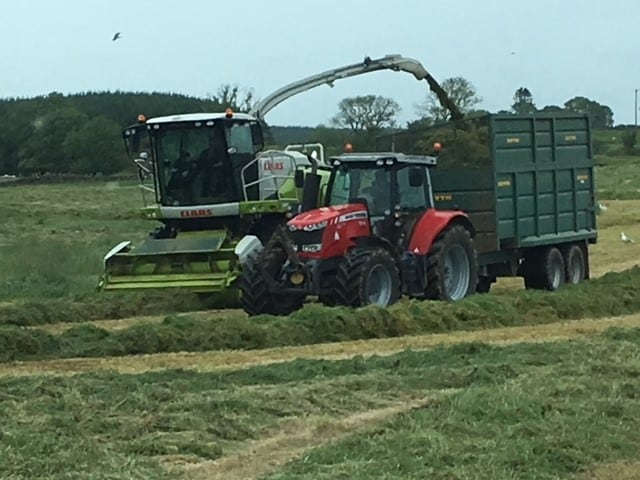In a meeting co-ordinated by NFU Scotland, Scottish stakeholders have met in Edinburgh this week on the 1st of August, identifying solutions to the feed and fodder shortfalls faced by Scottish farmers and crofters this autumn and winter.
In an exceptional year, months of cold, wet weather last winter and spring have been followed by the hottest, driest spell for a generation. That has had a huge impact. For livestock farmers, grass growth for cattle and sheep has ground to a halt, many are already feeding hay and silage that was intended for the coming winter and supplies of all feed and bedding are challenging to secure.
For cereal growers, early indications are that the winter barley harvest has been, at best, average. Spring barley, sown during a cold, wet spring, will see its harvest start in earnest in the coming weeks and spring barley is Scotland’s most important arable crop.
Organisations attending today’s meeting included Scottish Government; Scottish Beef Association; Agricultural and Horticultural Development Board (AHDB); Scottish Agricultural Organisation Society (SAOS); Scottish Machinery Ring Association; Scotland’s rural charity RSABI; Scottish Dairy Hub; Maltsters Association of Great Britain; Agricultural Industries Confederation (AIC); NSA Scotland; Scotch Whisky Association; SAC Consulting and Quality Meat Scotland (QMS).
NFU Scotland representatives included Vice Presidents Martin Kennedy and Gary Mitchell; Livestock Committee Chairman Charlie Adam; Combinable Crops Committee Chairman Ian Sands and Less Favoured Areas Committee Chairman Robert MacDonald.
Speaking afterwards, NFUS Vice President Martin Kennedy, who chaired the meeting said: “Exceptionally volatile weather over the past 12 months has made this a costly and difficult time for all farmers and crofters. That is having an impact that no one could have predicted. It was hugely worthwhile pulling in key stakeholders as we all work to identify short-term solutions that may address the serious shortfall in feed and fodder that is emerging.
“There is no silver bullet, but farmers can be reassured that help and advice is available from several of those round the table today.”
It was agreed that the following actions are required:
- There is a need for all to assess their fodder and bedding requirements for the winter ahead. Discussions should be had with agronomists, feed representatives and advisers on how to make the best use of what is available. Even if already completed, there is benefit in discussing your plan with others. This will allow orderly selling wherever possible.
- Encourage as many people to bale straw as they can. Those who require straw should place orders now.
- Scottish Government should pay at least 90% of the basic payment scheme in October as they did last year.
- Scottish Government should bring forward the payment of all pillar 2 payments.
- The UK Government must investigate the possibility of paying Renewable Heat Incentive to anaerobic digestion plants who voluntarily choose to divert their distillery by products to animal feed.
- The Government must consider the long-term impact on animal feed supply because of the growth in AD plants.
- Scottish Government must request that Europe relax the 3-crop rule requirement to allow growers more time to bale straw rather than plant winter crops.
- Scottish Government should shorten the EFA fallow period so that it runs from 15 April 2019 to 15 July 2019 to allow a fodder crop to be grown over the autumn and be available for stock in early spring.
- Scottish Government should relax their rules that require ‘Green Manure crops’ like clover, peas and oats to be ploughed in after 15 August as this could be used for fodder
- Beef efficiency scheme roadshows in September to discuss nutrition should be opened to all livestock farmers, not just scheme members.
- Machinery rings have a database of available grazing to let. Livestock farmers should be encouraged to notify them of either their grazing availability or requirements.
- Sellers and buyers of store lambs should consider if, depending on grass availability, delivery of the stock can be deferred to a time that suits both parties.
- AHDB and SAC consulting asked to produce a factsheet highlighting the most efficient use of straw, whether it be for fodder or bedding.
Mr Kennedy added: “Many have already started planning and through our #NFUSHowDoYouPlan campaign, where we are urging farmers and crofters to plan ahead; consider alternatives and collaborate. The sooner farmers start that process, the better.
“In the past few weeks, we have seen examples of arable growers turning off the choppers on their combines and baling more straw for their livestock neighbours; grass margins around arable fields have been baled for fodder; plantings of fodder crops like kale are on the rise and livestock keepers have shifted from bedding their animals on barley straw to alternatives.
“This is set to be an extremely challenging autumn and winter, but those round the table today are committed to helping the industry through it.”






